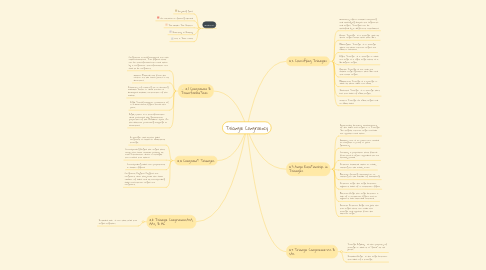Triangle Congruency
by Imani Sutton

1. Guidelines
1.1. Anything goes!
1.2. No criticism or flaming allowed
1.3. The Wilder The Better
1.4. Quantity is Quality
1.5. Set a Time Limit
2. 4.1 Congruence & Transformations
2.1. Congruence transformations are also called isometries. Two figures that can be transformed into each other by a congruence transformation are said to be congruent.
2.2. Dilation-Extends out from the center, at the same points in all directions.
2.3. Isometry-of, relating to, or denoting muscular action in which tension is developed without contraction of the muscle.
2.4. Rigid Transformation-Movement of a 2 dimensional figure across the plane.
2.5. Rigid Motion-is a transformation which preserves the geometrical properties of the Euclidean space. Or, the distance-preserving mappings or isometries.
3. 4.4 Congruent Triangles
3.1. A triangle with all the sides congruent is called an equilateral triangle.
3.2. Corresponding Angles-the angles that occupy the same relative position at each intersection where a straight line crosses two others
3.3. Corresponding Sides-are proportional in similar figures
3.4. Congruent Polygons-Polygons are congruent when they have the same number of sides, and all corresponding sides and interior angles are congruent.
4. 4.6 Triangle Congruence:ASA, AAS, & HL
4.1. Included Side- is one that links two angles together.
5. 4.2 Classifying Triangles
5.1. Geometry often involves comparing and classifying shapes, line segments and angles. Triangles can be classified by 2 different attributes.
5.2. Acute Trianlge- is a triangle with all three angles acute (less than 90°).
5.3. Equiangular Triangle- is a triangle where all three interior angles are equal in measure.
5.4. Right Triangle- is a triangle in which one angle is a right angle (that is, a 90-degree angle).
5.5. Obtuse Triangle-is one with one obtuse angle (greater than 90°) and two acute angles.
5.6. Equilateral Triangle-is a triangle in which all three sides are equal.
5.7. Isosceles Triangle- is a triangle that has two sides of equal length.
5.8. Scalene Triangle-No equal angles and no equal sides
6. 4.3 Angle Relationships in Triangles
6.1. Relationship between measurement of the sides and angles in a Triangle: The largest interior angle and side are opposite each other.
6.2. Auxiliary Line-is an extra line needed to complete a proof in plane geometry.
6.3. Corollary-a proposition that follows from (and is often appended to) one already proved.
6.4. Interior-situated within or inside; relating to the inside; inner:
6.5. Exterior-forming, situated on, or relating to the outside of something:
6.6. Interior angle-the angle between adjacent sides of a rectilinear figure.
6.7. Exterior Angle-the angle between a side of a rectilinear figure and an adjacent side extended outward.
6.8. Remote Interior Angle-are just the two angles that are inside the triangle and opposite from the exterior angle.
7. 4.5 Triangle Congruence:SSS & SAS
7.1. Triangle Rigidity- as the property of triangle in which it is "fixed" at its joints.
7.2. Included Angle- is the angle between two sides of a triangle.


